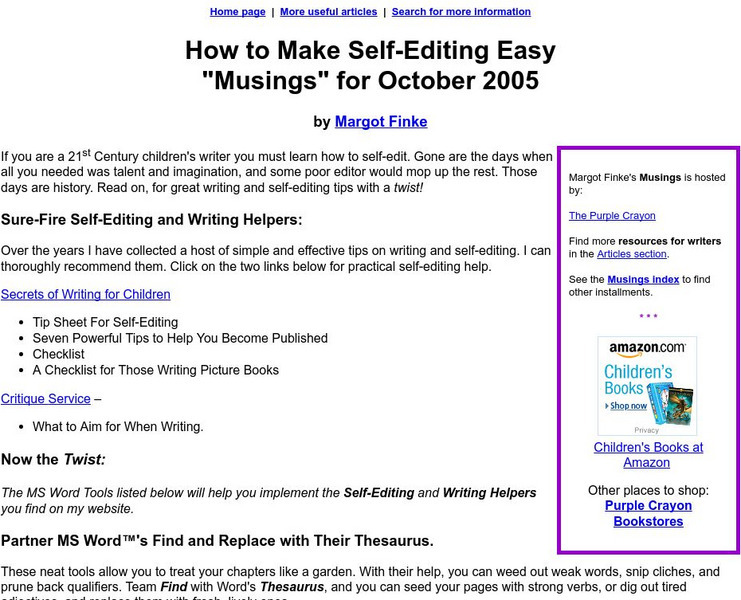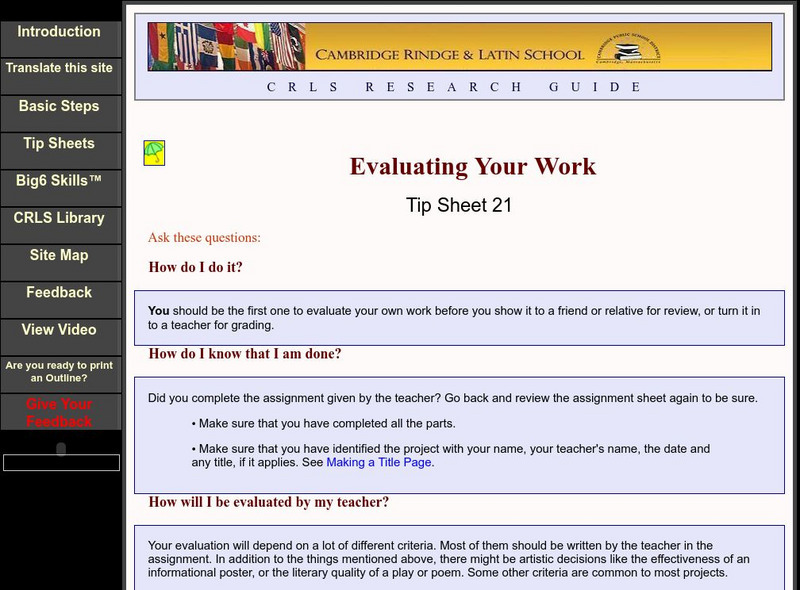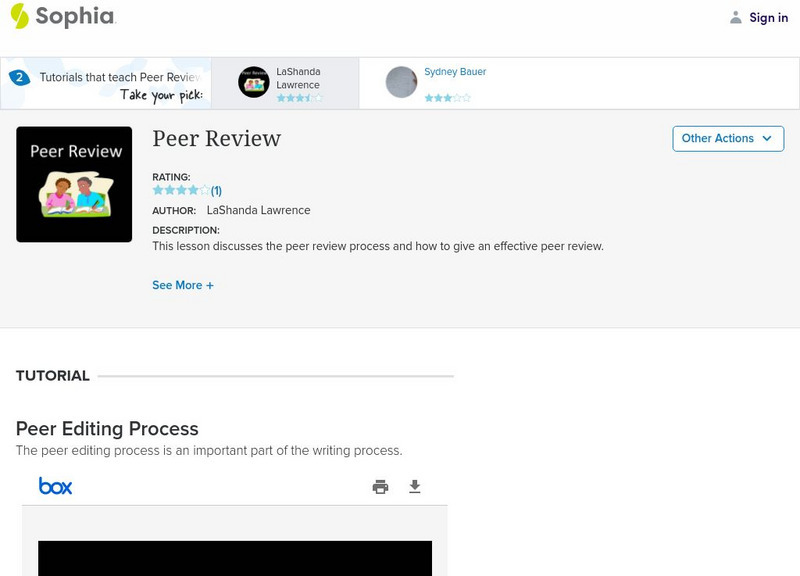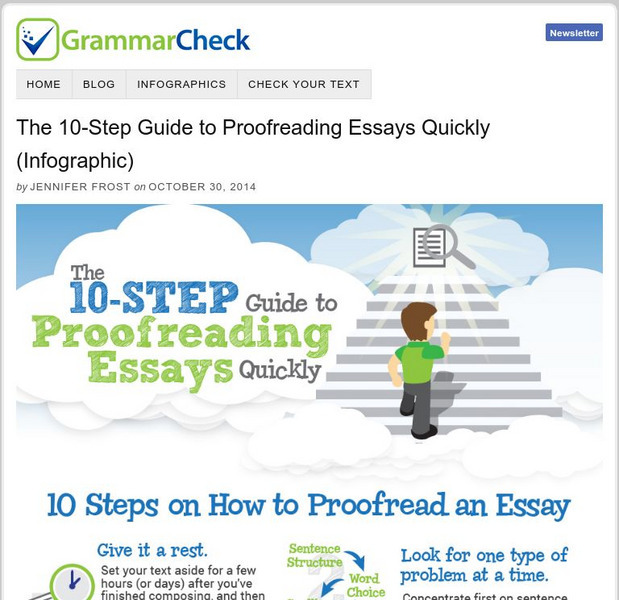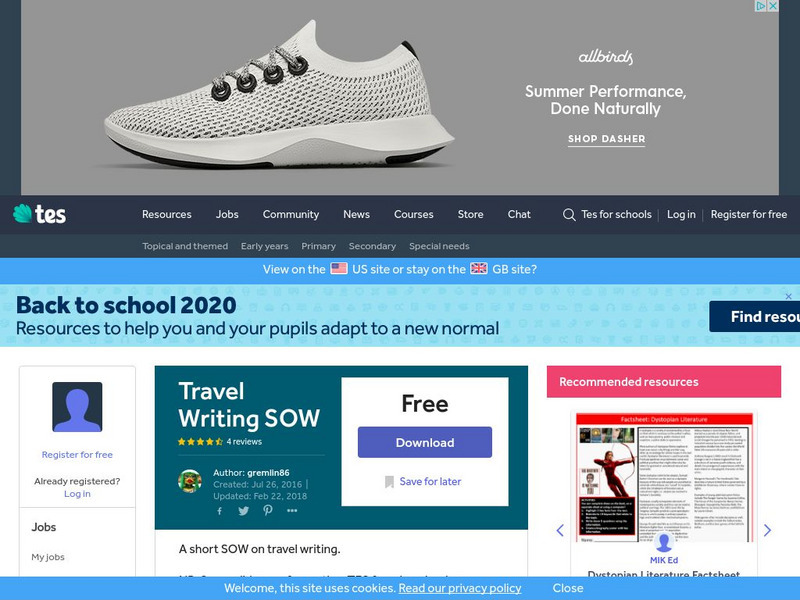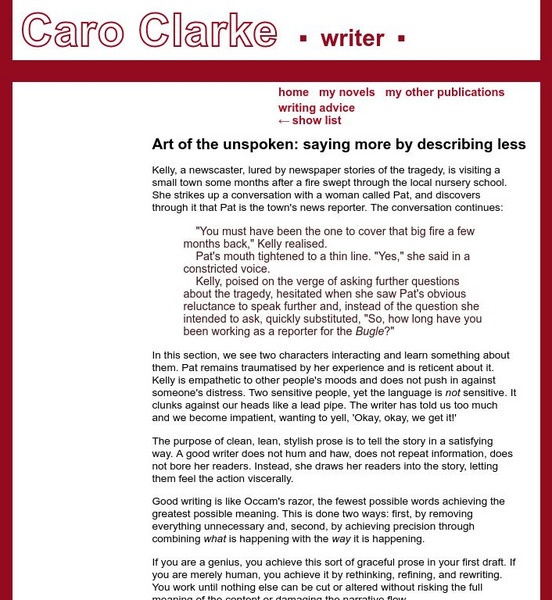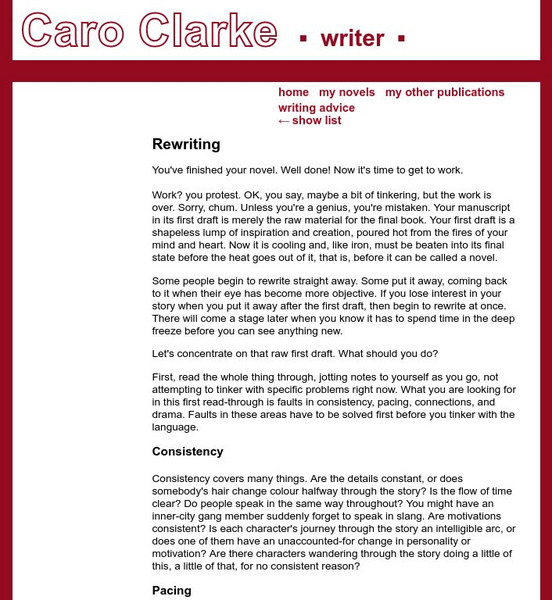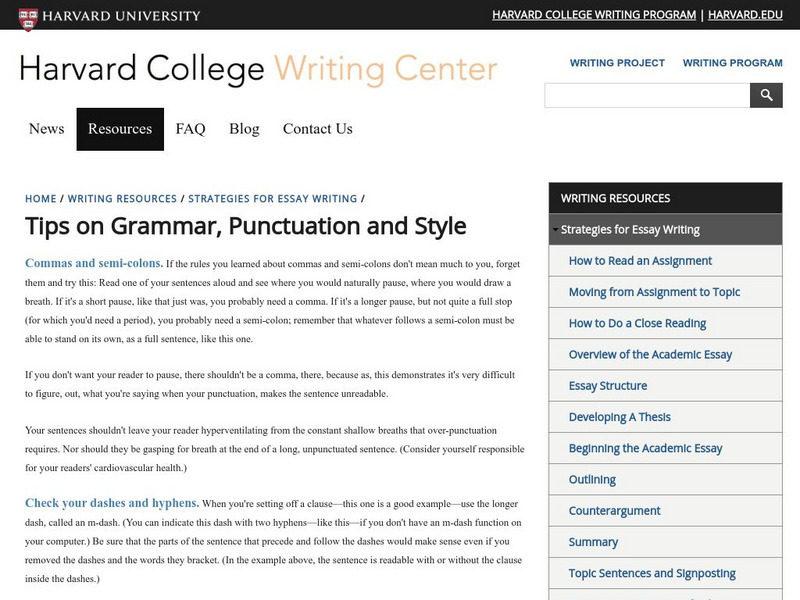Scholastic
Scholastic: Write It: Memoir
Write It Memoir offers a complete writing workshop to develop your personal story. Search your memory through the brainstorming activities to launch your piece. Draft a map of the memories along with reading other models. As the process...
US Department of Labor
Bureau of Labor Statistics: Writers and Editors
This is from the U.S. Occupational Outlook Handbook. It provides a profile of the writing and editing careers, including information on working conditions, employment opportunities, qualifications, job outlook, and earnings.
Harold D. Underdown
How to Make Self Editing Easy
Provides several strategies for easing the difficult process of editing your work (site pertains to writing children's literature). Includes mainly electronic methods of making self-editing easy.
Cambridge Rindge & Latin School
Cambridge Rindge & Latin School: Evaluating Your Work
An excellent tip sheet on how to evaluate and edit a completed draft of a research paper. Includes in-depth information and examples.
Other
Spelling police.com: Proofreaders' Marks
A general list of marks and symbols a proofreader may use in correcting and editing a piece of written work.
Other
Paradigm Online Writing Assistant: Occasions for Informal Essays
What are the occasions for informal essays? Use this informative site to learn more about when and how to write these types of informal essays.
Grammarly
Grammarly Handbook: Shifts in Writing
Five areas to edit for shifts in writing: Consistent Point of View, Consistent Verb Tenses, Verbs Consistent in Mood and Voice, Shifts from Indirect to Direct Questions/Quotations, and Shifts from British to American English. Each area...
Grammarly
Grammarly Handbook: Revising and Editing the Draft
Tips for revising and editing a rough draft. Links to additional information on Global Revisions, Editing Sentences, and Proofreading is provided.
Bartleby
Bartleby.com: Strunk's the Elements of Style
Bartleby.com's online version of William Strunk, Jr.'s classic reference book, "The Elements of Style."
McGraw Hill
Mc Graw Hill: Glenco: Writer's Choice: Grade 7:grammar, Usage, and Mechanics
Two interactive exercises where students retype three short paragraphs while making corrections in spelling, punctuation, capitalization, grammar, and usage. When finished, answers can be displayed so students can check the accuracy of...
McGraw Hill
Mc Graw Hill: Glenco: Writer's Choice: Grade 8: Grammar, Usage, and Mechanics
Two interactive exercises where students retype three short paragraphs while making corrections in spelling, punctuation, capitalization, grammar, and usage. When finished, answers can be displayed so students can check the accuracy of...
City University of New York
College of Staten Island Library: How to Write an Essay
Resource defines what an essay is, the parts of an essay and their functions, and also discusses the editing process and how important it is to check a draft for completeness and high quality. Includes a link to an online guide to citing...
Other
Dena Harrison: Narrative Self Editing Questions [Pdf]
A printable PDF providing eleven questions young writers can ask themselves as they edit their narrative pieces.
Sophia Learning
Sophia: Peer Review: Lesson 2
This lesson discusses the peer review process and how to give an effective peer review. It is 2 of 2 in the series titled "Peer Review."
Grammar Check
Grammar Check: The 10 Step Guide to Proofreading Essays Quickly (Infographic)
This infographic is provided to help students with proofreading essays. Students will learn common essay writing mistakes and how to fix them. Students will also find fast and easy essay writing tips. Students will learn how to quickly...
TES Global
Tes: Travel Writing Sow
[Free Registration/Login Required] A 100-slide PowerPoint presentation will guide students through a descriptive writing task. Students will be write extensive pieces about a travel experience.
Caro Clarke
Not Stopping the Reader: How to Avoid Stumbling Blocks
This is the eighth article in a series that focuses on helping the new novel author. This article looks at how the author can avoid creating stumbling blocks that disrupt the flow of the novel.
Caro Clarke
Explaining Too Much: Why More Is Less
This is the eleventh article in a series that is designed to help the new novel author. This article focuses on how to eliminate needless information in your novel. The key is to not explain too much about the action.
Caro Clarke
The Art of the Unspoken: Saying More by Describing Less
This is the thirteenth article in a series that was developed to help the new novel author. This article focuses on how good descriptions aren't necessarily connected with a lot of words, good descriptions are clean and to the point.
Caro Clarke
Historical Fiction: Who Rules?
This is the fifteenth article in a series designed to help the new novel author. This article focuses on the genre of historical fiction and the role of the author. Is the author a researcher or a story-teller?
Caro Clarke
Rewriting
This is the 17th article in a series that helps the new fiction author with the final step--revision.
Other
Efa: Editorial Freelancers Association
This page is for freelance journalists who have narrowed their selected field to editorials and editorial columns. Newly combined with the Editorial Freelancers Association, this site contains materials from both organizations.
Caro Clarke
Caro Clarke: Description: What's It For?
This is the twelfth article in a series that is designed to help the new novel writer. This article focuses on how to effectively use descriptions in any writing.
Harvard University
Harvard Writing Center: Tips on Grammar, Punctuation and Style
Rather than lists of rules, this site provides practical advice on the use of commas, semicolons, dashes, hyphens, abbreviations, acronyms, split infinitives, "this," "that," italics, and underlining. CCSS.ELA-Literacy.CCRA.L.2




